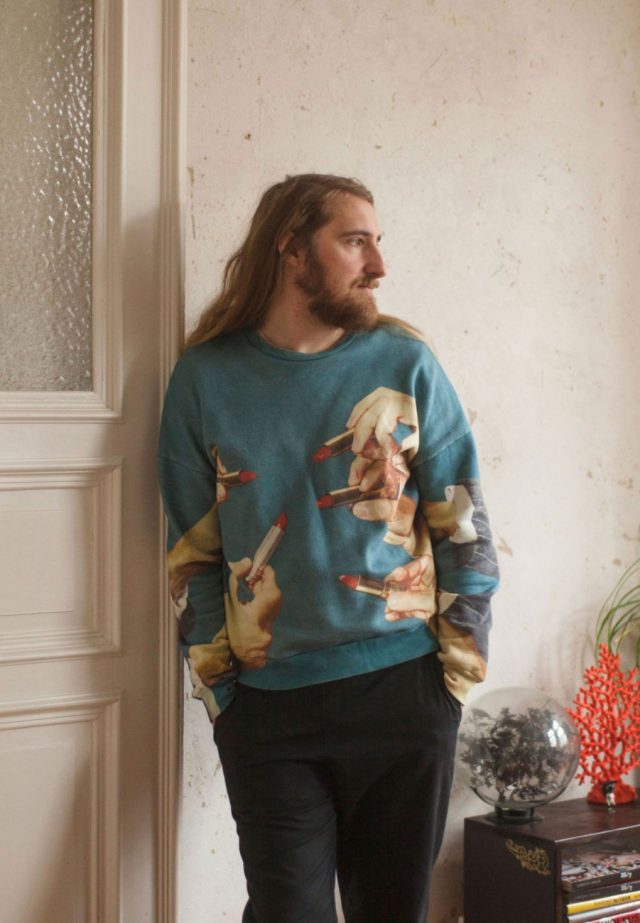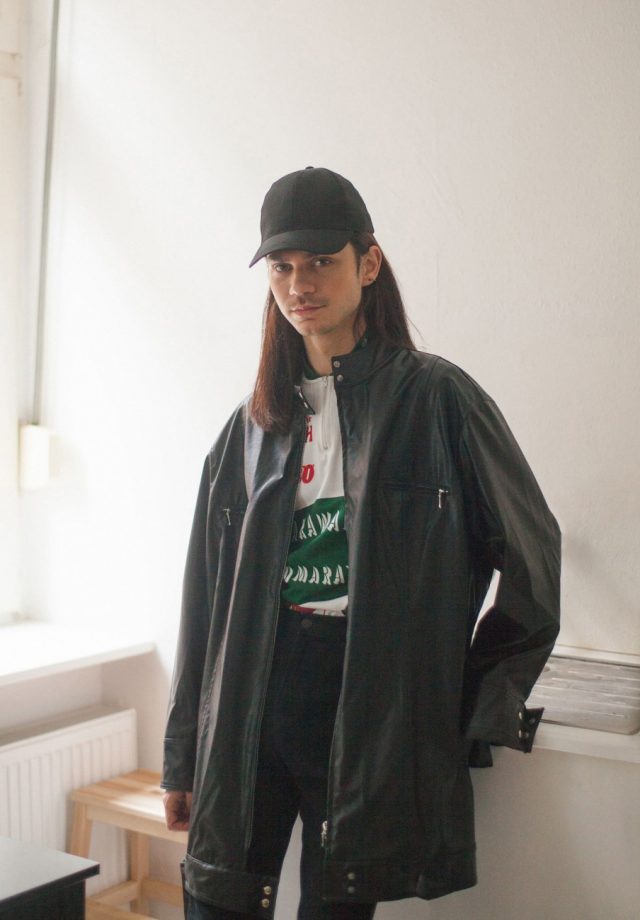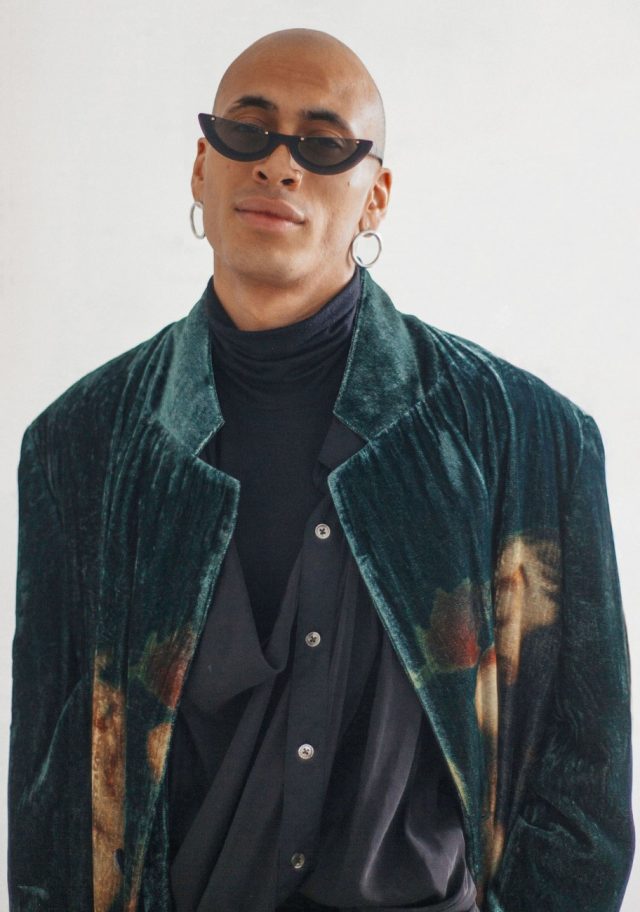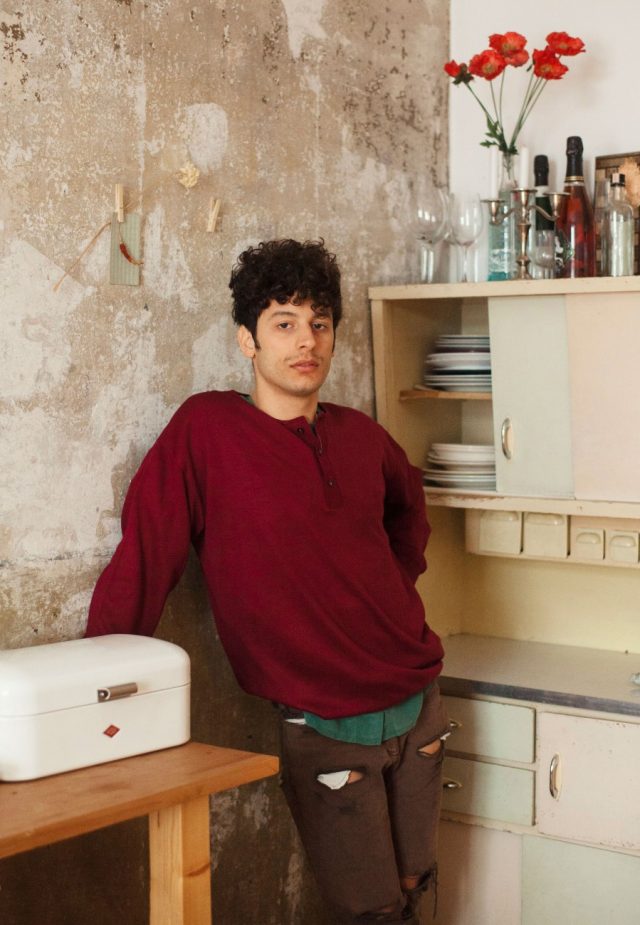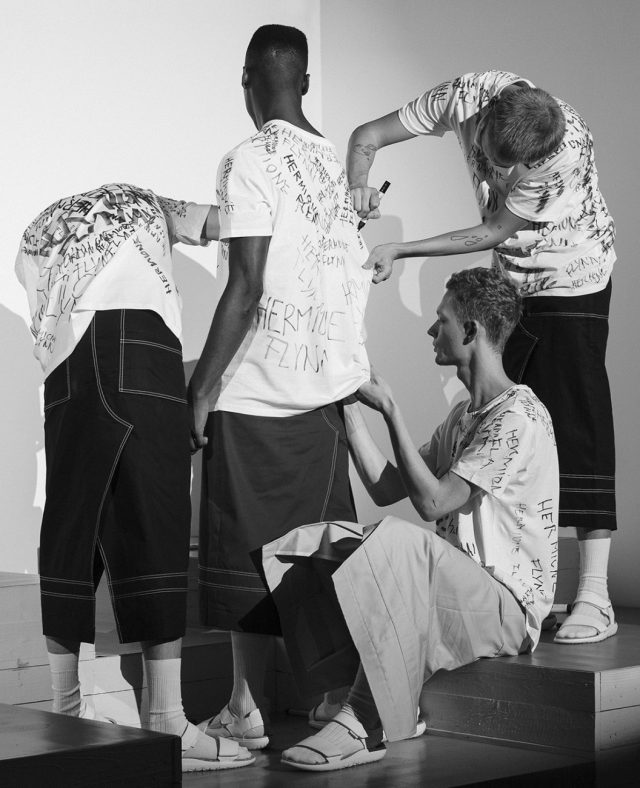This week we met Ariel William Orah, a multimedia artist with a weakness for vintage glasses. We talked about Trainspotting, redefining androgyny, and about esthetics inspired by awkwardness and melancholy.

Graphics by Elena Scilinguo
Œ Magazine: When I first approached you on that Neukölln bus, you were on your way to a wedding, wearing a mint green blazer, a dress over a pair of trousers and platform shoes. Is that a typical Ariel outfit?
Ariel: Yes, it has become my basic template. I have the same blazer and dress in different colors and different sizes. And the trousers are actually nurse pants! Something I don’t have right now is a normal pair of trousers, jeans for example.
ΠMagazine: What do you like about this look?
Ariel: I like the mix of masculine and feminine.
ΠMagazine: What do you consider feminine about it? What masculine?
Ariel: Masculine: long hair with moustache, blazers; feminine: dress and platform shoes

ΠMagazine: When was the first time you wore a dress?
Ariel: When I was about 27, I think… 17 was the first time I wore female shirt and trousers
Œ Magazine: Isn’t that a pretty bold choice for a teenager in Indonesia? You grew up in Bandung, do you remember what inspired that choice?
Ariel: Probably Trainspotting! The movie was a major life-style influence. It was the peak of my teenage years when the movie came to the cinema in 1996, I was 16 or 17 and there were political riots in Indonesia. The soundtrack is incredible, that mix of 90s Electro and Brit Pop, but also the plot, the confrontation with new drugs –they were new at the time, and the way the characters dressed! It was my first encounter with hooligan culture, slim jeans plus Fred Perry polo’s plus Dr. Marten’s, but also with awkwardness as a statement and androgyny. Meanwhile Indonesia was still a very conservative and mostly Muslim country.
Œ Magazine: Not exactly Edinburgh…
Ariel: Right. And it’s hard to imagine the impact of a movie like this from the outside. It really made kids curious about the underground and encouraged them to explore and embrace their teenage weirdness and experiment: girls clothes on men and also tattoos, for example! It sounds really cliché but in Bandung, having even the smallest tattoo meant having been to jail, dishonor for the families, and so on. Instead, these things started becoming a vehicle against uptight political as well as religious thinking.
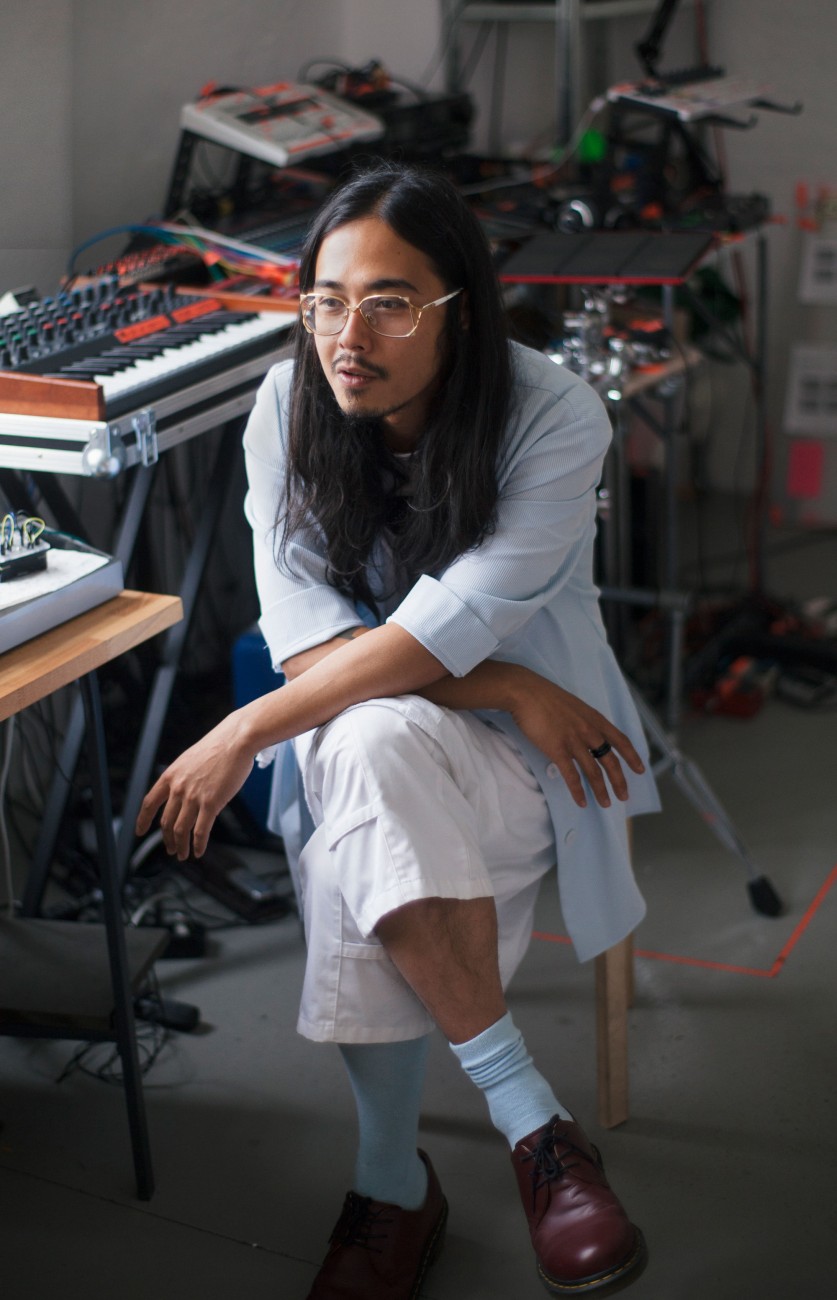
ΠMagazine: Do you remember how you felt the first times you wore a dress?
Ariel: It always gave me some sort of excitement, of high, if you will. Trainspotting really created this “subculture Sehnsucht” in me, so I didn’t mind being part of a minority, being looked at and judged. Furthermore, back in the day, freedom of expression was rather circumscribed, wearing a dress was trying to push those boundaries a little bit.
ΠMagazine: How exactly would people react?
Ariel: Strangers yelling “gay” or “criminal” at you, trying to pick a fight were common things, but luckily I was never interested in the macho-martial-arts thing (laughs).
ΠMagazine: (laughs) I see. Do you remember talking about clothes with your friends?
Ariel: I remember we were all about the music, and so were our clothes.

via @_ravenative_
ΠMagazine: What music were you into at the time?
Ariel: I listened to various 80s 90s flings from New kids on the block, British Shoegaze and later Brit pop, American alternatives such as Sonic Youths and Smashing Pumpkins.
Œ Magazine: When do you think your “style” started taking the shape it has today?
Ariel: Probably when I started making music and performing with a band in 2003/04. We wanted to give it a real shot and needed press photos, so we started thinking about an image and attitude for the band. That was probably my first “product packaging” (laughs). We had mood boards with photos of bands we were into —a lot of 2000 indie bands like the Strokes and Interpol but also some British Goth, Shoegaze music from the 80’s like The Cure, The Birthday Party, and Jesus and Marry Chain.
ΠMagazine: Do you remember a piece of clothing or accessory you decided to adapt? What were you hoping to translate by doing so?
Ariel: At the time, it was a rather shallow adaptation. The only thing I can think of is the Fred Perry shirt. We appreciated British skinheads playing Jamaican music and trying to build an image around it that was opposite to one promoted by Neo-Nazi skinheads.

ΠMagazine: When did you move to Berlin?
Ariel: My first encounter with Berlin was 2007. At the time, I was in in Erfurt for an exchange semester. I then moved to Berlin for good in 2011.
ΠMagazine: Try telling me about a significant transition in your Berlin life, by describing how your wardrobe changed in those circumstances.
Ariel: Hmm. So right after moving here 2012/13, I was into the Berlin avant-garde electronic culture, and by that I mean the whole package, music, environment (club and venues), lifestyle, and all the people in the scene that had a significant influence. For example I would go to venues such as Berghain and Katerholzig or forward thinking festivals like Berlin Atonal and CTM. And during that period, black was pretty dominant.

ΠMagazine: But how come black, out of all colors, to show appreciation and belonging to this scene?
Ariel: There was always something mysterious about the Berlin techno scene. The rustic resistance, and absolute freedom And let’s not forget that beauty is different for everyone. For example, I kind of like the idea of misery. To me sadness holds something very attractive.
ΠMagazine: As an artist, is this misery something you take inspiration from?
Ariel: Of course. I’m way more productive when I’m miserable. Luckily, I’m pretty much a miserable person (laughs), not that I’m sad all the time, but I get frantic, questioning stuff. It’s so much more exciting to write something or to create music based on sadness rather than on happiness. Some of the best music is rooted in melancholy.
Œ Magazine: You’re a romantic! Misery inspires your work and the music you create. Does it still inspire you choices in matter of clothes today?
Ariel: Something like that. Although to be fair, both the mood and music have influenced the shape of my clothes more than the color.

Œ Magazine:(laughs) That’s interesting! So when you have a bad hair day and listen to sad tunes you wear squares and when you’re euphoric and feel like dancing you wear triangles?
Ariel: (laughs) More in the way that sometimes I wear very loose things and sometimes I wear very fitted, tight clothes.
ΠMagazine: Why did you stop wearing black?
Ariel: It stopped feeling so quintessential and I don’t like how today people just run to H&M and buy some pseudo-Berghain outfit.
ΠMagazine: So what happened after black?
Ariel: After the black bias, it was long hair, women’s dresses and stiletto shoes. These things happened gradually and became daily essentials.

ΠMagazine: How does your hair fit into all this?
Ariel: Well, it’s kind of a Yohji Yamamoto thing, I really like it. He’s a pretty cool dude. I can’t wait for it to be all gray!
Œ Magazine: Is there anything you always wear and can’t leave the house without?
Ariel: My glasses. I collect glasses actually. Mine are from this Passau brand Cazal that produced glasses in the 70s and 80s. I like collecting them and they have always been my signature.
ΠMagazine: If you had to invent name for your style what would it be?
Ariel: “Transcendent Travolta”. Travolta from John Travolta of course. Pulp Fiction was another big influence. In that movie he’s so preppy and goofy, I just think that will stay in me forever. This is actually a cool name, isn’t it? Maybe for some band (laughs).
ΠMagazine: Or your next song title! What is something you secretly envy in other men on the street?
Ariel: The 70s flair trousers, but I simply don’t have the legs for them.
Œ Magazine: From where you are standing, what is the men’s style panorama like in Berlin?
Ariel: Things are still very experimental; the David Bowie spirit is still here and very much alive. By the way, I basically moved to Berlin because he once lived here (laughs). I was such a big fan of his. I think Berlin style is really the product of all these different people coming here because of what’s happening in their countries, and I’m not talking about the people that escape to Berlin to open bagel shops, I’m thinking of the Lebanese or people from Turkey, Russia and Vietnam bringing their traditions, cultures and costumes and mixing them.
ΠMagazine: What do you think was my first impression of you?
Ariel: Well, you must of thought there is something unusual. I think you approached to me because I looked different to you.


